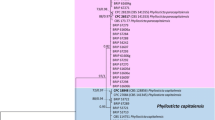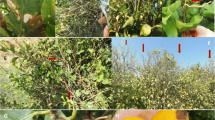Abstract
Phyllosticta species associated with diseases of four commercial Citrus species grown in China are reported. Totally, 496 Phyllosticta strains were isolated from mandarins (Citrus reticulata), pomeloes (C. maxima), oranges (C. sinensis) and lemons (C. limon) in the main citrus producing regions across China, and 74 strains were selected for phylogenetic analysis. Analyses inferred from the sequences of internal transcribed spacer region (ITS1, 5.8S nrDNA and ITS2), partial translation elongation factor 1-alpha (TEF1) and partial actin gene (ACT), showed these representative Phyllosticta isolates clustered in four distinct clades corresponding to three known, and one undescribed species. The newly resolved taxon, Phyllosticta citrichinaensis was isolated from leaves and fruits of all four Citrus species and is introduced in this paper. This taxon caused minor damage, showing irregular spots or freckles. Phyllosticta citriasiana, associated with tan spot of pomeloes, was isolated only from pomeloes, and never from lemons, mandarins and oranges. Phyllosticta citricarpa, the citrus black spot pathogen, which is presently subjected to phytosanitary legislation in the EU and United States, was isolated from lemons, mandarins and oranges, but never from pomeloes. The isolates of P. citricarpa clustered in two subclades, one from mandarins, the other from oranges and lemons. P. capitalensis was isolated from all four Citrus species as an endophyte, causing false melanose, or together with P. citricarpa or P. citriasiana. Morphological, cultural and biochemical characters were consistent with the results of phylogenetic analysis. In addition, a specific primer pair Pca8/ITS4 was designed and selected, and its corresponding PCR procedure was developed for the detection of P. citriasiana in this study.








Similar content being viewed by others
References
Baayen RP, Bonants PJM, Verkley G, Carroll GC, Van der Aa HA, De Weerdt M, Van Brouwershaven IR, Schutte GC, Maccheroni W Jr, de Blanco CG, Azevedo JL (2002) Nonpathogenic isolates of the citrus black spot fungus, Guignardia citricarpa, identified as a cosmopolitan endophyte of woody plants, G. mangiferae (Phyllosticta capitalensis). Phytopathology 92(5):464–477
Bai JK (2003) Flora fungorum sinicorum. Science press 15:41–43
Bonants PJM, Carroll GC, de Weerdt M, van Brouwershaven IR, Baayen RP (2003) Development and validation of a fast PCR-based detection method for pathogenic isolates of the citrus black spot fungus, Guignardia citricarpa. Eur J Plant Pathol 109(5):503–513
CABI (2006) Crop protection compendium edition. CAB International, Wallingford (GB)
CABI/EPPO (1998) Distribution maps of plant diseases, No. 204. CAB International, Wallingford (GB)
Cai L, Giraud T, Zhang N, Begerow D, Cai G, Shivas RG (2011) The evolution of species concepts and species recognition criteria in plant pathogenic fungi. Fungal Diversity 50:121–133
Carbone I, Kohn LM (1999) A method for designing primer sets for speciation studies in filamentous ascomycetes. Mycologia 91:553–556
Chiu RJ (1955) Studies on black spot of citrus. J Agric For 9:1–18
Crous PW, Slippers B, Wingfield MJ, Rheeder J, Marasas WFO, Philips AJL, Alves A, Burgess T, Barber P, Groenewald JZ (2006) Phylogenetic lineages in the Botryosphaeriaceae. Stud Mycol 55(1):235–253
Deng X (2008) Citrus varieties in China. China agriculture press, Beijing
Di Pietro A, Roncero MIG (1996) Endopolygalacturonase from Fusarium oxysporum f. sp. lycopersici: Purification, characterization, and production during infection of tomato plants. Phytopathology 86(12):1324–1330
Everett KR, Rees-George J (2006) Reclassification of an isolate of Guignardia citricarpa from New Zealand as Guignardia mangiferae by sequence analysis. Plant Pathol 55:194–199
Fawcett HS (1936) Citrus diseases and their control. McGraw-Hill Publishing Company, London, p 656
Glienke C, Pereira OL, Stringari D, Fabris J, Kava-Cordeiro V, Galli-Terasawa L, Cunnington J, Shivas RG, Groenewald JZ, Crous PW (2011) Endophytic and pathogenic Phyllosticta species, with reference to those associated with Citrus Black Spot. Persoonia-Molecular Phylogeny and Evolution of Fungi 26(1):47–56
Goh TK (1999) Single-spore isolation using a hand-made glass needle. Fungal Diversity 2:47–63
Huang DP, Xiong SJ, Huang LM (2009) Epidemic and control of Citrus Black Spot on Citrus maxima. South China Fruits 38(2):45
Hyde KD, Cai L, Cannon PF, Crouch JA, Crous PW, Damm U, Goodwin PH, Chen H, Johnston PR, Jones EBG, Liu ZY, McKenzie EHC, Moriwaki J, Noireung P, Pennycook SR, Pfenning LH, Prihastuti H, Sato T, Shivas RG, Taylor PWJ, Tan YP, Weir BS, Yang YL, Zhang JZ (2009) Colletotrichum – names in current use. Fungal Diversity 39:147–182
Kiely TB (1948) Preliminary studies of Guignardia citricarpa nov.sp. the ascigerous state of Phoma citricarpa McAlp. and its relation to black spot of citrus. Proceedings of the Linnaean Society of New South Wales 73:249–292
Ko Ko TW, Moslem MA, Abdelsalam K, Chamyuang S, Cheewangkoon R, Chukeatirote E, Jonglaekha N, Kobsueb R, McKenzie EHC, Promputtha I, Soytong K, To-anun C, Wikee S, Wulandari NF, Hyde KD (2011) The need for re-inventory of Thai phytopathogens. Chiang Mai J Sci (in press)
Kotzé JM (1981) Epidemiology and control of citrus black spot in South Africa. Plant Dis 65(12):945–950
Kotzé JM (2000) Black spot. In: Whiteside JO, Garsney SM, Timmer LW (eds) Compendium of citrus diseases. The American Phytopathological Society Press, St. Paul, pp 23–25
McOnie KC (1964) The latent occurrence in citrus and other hosts of a Guignardia easily confused with G. citricarpa, the citrus black spot pathogen. Phytopathology 54:40–43
Motohashi K, Nishikawa J, Akiba M, Nakashima C (2008) Studies on the Japanese species belonging to the genus Phyllosticta (1). Mycoscience 49(1):11–18
Motohashi K, Inaba S, Anzai K, Takamatsu S, Nakashima C (2009) Phylogenetic analyses of Japanese species of Phyllosticta sensu stricto. Mycoscience 50(4):291–302
OEPP/EPPO (2009) Guignardia citricarpa. Bulletin OEPP/EPPO Bulletin 39:318–327
Okane I, Nakagiri A, Ito T (2001) Identity of Guignardia sp. inhabiting ericaceous plants. Canadian J Botany 79(1):101–109
Okane I, Lumyong S, Nakagiri A, Ito T (2003) Extensive host range of an endophytic fungus, Guignardia endophyllicola (anamorph: Phyllosticta capitalensis). Mycoscience 44(5):353–363
Paul I, Van Jaarsveld AS, Korsten L, Hattingh V (2005) The potential global geographical distribution of Citrus Black Spot caused by Guignardia citricarpa (Kiely): likelihood of disease establishment in the European Union. Crop Prot 24(4):297–308
Peres NA, Harakava R, Carroll GC, Adaskaveg JE, Timmer LW (2007) Comparison of molecular procedures for detection and identification of Guignardia citricarpa and G. mangiferae. Plant Disease 91(5):525–531
Phoulivong S, Cai L, Chen H, McKenzie EHC, Abdelsalam K, Chukeatirote E, Hyde KD (2010) Colletotrichum gloeosporioides is not a common pathogen on tropical fruits. Fungal Diversity 44:33–43
Prihastuti H, Cai L, Chen H, McKenzie EHC, Hyde KD (2009) Characterization of Colletotrichum species associated with coffee berries in northern Thailand. Fungal Divers 39:89–109
Pu ZX, Huang ZD, Huang QB, Zhang XY, Lu LM, Chen GQ (2009) Epidemic and control of citrus black spot on Citrus reticulata in Taizhou region. Citrus Zhejiang 26:33–35
Schubert T, Sutton B, Jeyaprakash A (2010) Citrus black spot (Guignardia citricarpa) discovered in Florida.
Summerell BA, Laurence MH, Liew ECY, Leslie JF (2010) Biogeography and phylogeography of Fusarium: a review. Fungal Divers 44:3–13
Summerell BA, Leslie JF, Liew ECY, Laurence MH, Bullock S, Petrovic T, Bentley AR, Howard CG, Peterson SA, Walsh JL, Burgess LW (2011) Fusarium species associated with plants in Australia. Fungal Divers 46:1–27
Sutton BC & Waterston JM (1966) Guignardia citricarpa. CMI Descriptions of Pathogenic Fungi and Bacteria no. 85. CAB International, Wallingford (GB)
Tamura K, Dudley J, Nei M, Kumar S (2007) MEGA4: molecular evolutionary genetics analysis (MEGA) software version 4.0. Molecul Biol Evol 24(8):1596–1599
Thongkantha S, Lumyong S, McKenzie EHC, Hyde KD (2008) Fungal saprobes and pathogens occurrence on tissues of Dracaena loureiri and Pandanus spp. Fungal Divers 30(1):149–179
Van der Aa HA (1973) Studies in Phyllosticta. I. Stud Mycol 5:1¨-110
Van der Aa HA, Vanev S (2002) A revision of the species described in Phyllosticta. A revision of the species described in Phyllosticta
Van der Aa HA, Noordeloos ME, de Gruyter J (1990) Species concepts in some larger genera of the Coelomycetes. Stud Mycol 32:3–19
van Gent-Pelzer MPE, van Brouwershaven IR, Kox LFF, Bonants PJM (2007) A TaqMan PCR method for routine diagnosis of the quarantine fungus Guignardia citricarpa on citrus fruit. J Phytopathol 155(6):357–363
White TJ, Bruns T, Lee S, Taylor J (1990) Amplification and direct sequencing of fungal ribosomal RNA genes for phylogenetics. PCR protocols A guide to methods and applications 315–322
Wikee S, Cai L, Pairin N, McKenzie EHC, Su YY, Chukeatirote E, Thi HN, Bahkali AH, Moslem MA, Abdelsalam K, Hyde KD (2011a) Colletotrichum species from Jasmine (Jasminum sambac). Fungal Divers 46:171–182. doi:10.1007/s13225-010-0049-x
Wikee S, Chukeatirote E, McKenzie EHC, Bahkali AH, Hyde KD (2011b) Phyllosticta - biology, species recognition and names of phytopathogens currently in use. Fungal Divers 51
Wulandari NF, To-Anun C, Hyde KD, Duong LM, de Gruyter J, Meffert JP, Groenewald JZ, Crous PW (2009) Phyllosticta citriasiana sp. nov., the cause of Citrus tan spot of Citrus maxima in Asia. Fungal Divers 34:23–39
Xiao YG, Zhou JH, Lü LQ, Xiao YB, Zhang JR (2004) A study on the Black Spot of Citrus limon. J Sichuan Agric Univ 22(2):153–156
Zhang ZJ, Gong YY, Liang WW (2006) Fruits of Citrus maxima dipping difenoconazole to control citrus black spot. South China Fruits 35:20–21
Zhu WS, Lin BM, Chen H, Li SL (1979) Phoma citricarpa McAlp. Study. Chinese Citrus 3:36–42
Acknowledgments
Special thanks to Dr. Lei Cai (Institute of Microbiology, Chinese Academy of Sciences, Beijing China) and Dongliang Yu (Hangzhou Normal University, Zhejiang, China) for their helpful suggestions in phylogenetic analysis. This work was supported by the earmarked fund for Modern Agro-industry Technology Research System (MATRS) of China, the National Foundation of Natural Science of China (31071649). The Global Research Network for Fungal Biology and King Saud University are thanked for supporting this research. MFLU awarded grant No 53101020017 to study the genus Phyllosticta in northern Thailand and the National Research Council of Thailand awarded grant No 54201020004 to study the genus Phyllosticta in Thailand.
Author information
Authors and Affiliations
Corresponding author
Rights and permissions
About this article
Cite this article
Wang, X., Chen, G., Huang, F. et al. Phyllosticta species associated with citrus diseases in China. Fungal Diversity 52, 209–224 (2012). https://doi.org/10.1007/s13225-011-0140-y
Received:
Accepted:
Published:
Issue Date:
DOI: https://doi.org/10.1007/s13225-011-0140-y




